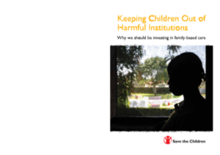The UN estimates that up to 8 million children around the world are living in care institutions. However, the actual number is likely to be far higher owing to chronic gaps in information. It is also likely to rise with the increasing impact of conflict, climate change and the HIV and AIDS pandemic on the poorest and most vulnerable families.
In many institutions, the standard of care is poor. Many children are abused and neglected. Children under three, in particular, are at risk of permanent developmental damage by not being cared for in a family setting. For all children, long term stays in institutions can have a lasting negative impact. The harm that can be caused to children by institutional care has been documented since the early 20th century.
Most children in what are known as orphanages or children’s homes are not in fact orphans. At least four out of five children in institutional care have one or both parents alive. Poverty and social exclusion are two of the main reasons why children are unable to live at home.
Families often feel that placing their children into care is the only way to ensure they get an education and enough food and other essentials. Discrimination and cultural taboos also mean that in some countries a disproportionate number of girls, disabled children and children from minority ethnic groups are relinquished or abandoned into care institutions. With support, the parents and extended families of many of these children could care for them.
Greater political and financial commitment is needed to tackle the poverty and social exclusion that drives families to give up their children, and to help build parents’ capacity to care for their children. In addition, greater priority must be given to developing good quality family-based care options – such as foster care and adoption – for children who need alternative families.
Experience shows that where there is political will children can be well cared for and protected. For example, Indonesia has embarked on a process of widespread reform to improve the quality of care in institutions and to shift policies and resources towards supporting children in their families. Sierra Leone has reunified many children with their families and is addressing its use of care institutions. Croatia has achieved important structural and legal changes to ensure that family and community-based care is given greater priority. South Africa has built social protection and other mechanisms to strengthen families and prevent unnecessary separation. Unfortunately, such examples are few and far between.
The new international Guidelines for the Appropriate Use and Conditions of Alternative Care for Children, which were finalized in 2009 after several years of consultation with governments and experts around the world, should be adopted and implemented as a matter of urgency. The design and delivery of national and local childcare and protection systems must be transformed to enable families to look after their own children and to ensure that children have access to positive care alternatives where necessary.
This will require a new era of political leadership to ensure that positive childcare and protection practices are pursued at every level. To this end, we are calling for:
-
Every government to make a long-term commitment to building family support services and family-based alternative care, and to tackling the overuse and misuse of residential care, in line with the Guidelines;
-
Governments to ensure that all forms of alternative care adhere to the principles and standards set out in the Guidelines;
-
Donors to ensure that funding is directed at preventative community and family support and at family-based alternative care.

